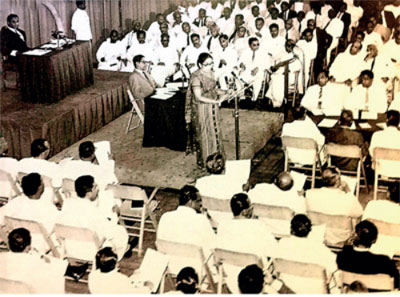Sri Lanka becomes a Republic
For nearly 50 years – 48 to be exact – Sri Lanka has been a Republic with its official name as the ‘Socialist Republic of Sri Lanka’.
It was on May 22, 1972 that the country became a Republic changing its name from ‘Ceylon’ to ‘Sri Lanka’ – a name that had been used from the days of the ancient Sinhalese kings but changed after foreign powers took over the country after 1505. In fact, the name used earlier was ‘Sri Lankadvipa’, meaning the ‘Island of
Sri Lanka’.

Prime Minister Sirimavo Bandaranaike addresses the Constituent Assembly.
Ceylon – as Sri Lanka was then known – gained Independence on February 4, 1948. Till then it was a Crown Colony in the British Empire for a little over 150 years after the British took over administering the country from the Dutch in 1796, who in turn had taken over from the Portuguese.
With the formation of the Republic, a President took the place of the Governor-General, ceremonial Head of State who was appointed by the British monarch (Queen Elizabeth II)
on the recommendation of the Government of Ceylon. The incumbent Governor-General William Gopallawa continued
to be the Head of State as the first Non-Executive President under the new constitution.
He was a nominee of the
Prime Minister and not an elected President.
Looking back on how the Republic was born, it was the Sirimavo Bandaranaike Government (she was the
Prime Minister) that decided
to draft a new constitution.
On a resolution by the
Prime Minister, the members
of the House of Representatives formed themselves into a Constituent Assembly at a meeting held at the Navarangahala in Colombo
on July 19, 1970. The Speaker, Stanley Tillekeratne was
elected as Chairman. Minister
of Plantation Industry,
Dr. Colvin R. de Silva was given the additional portfolio of Constitutional Affairs.
The signs of a new constitution started in June 1968 when the main Opposition parties in Parliament – the
Sri Lanka Freedom Party (SLFP), the Lanka Sama Samaja Party (LSSP) and the Communist
Party (CP) – formed a ‘United Front’ and agreed to establish
“a socialist democracy”.
The United Front won the general election held on
May 27, 1970 and a government was formed with Mrs. Sirimavo Bandaranaike as Prime Minister.
At that time the country had a bicameral legislature with two lawmaking institutions – the House of Representatives and the Senate. The former referred to as the ‘Lower House’ comprised of 95 members,
was elected by the people and six were appointed by the
Governor to represent minority communities. The Senate –
the ‘Upper House’ – with
30 members was a mix of nominated and elected members. Fifteen of them
were elected by the House of Representatives and the other 15 appointed by the Governor on the advice of the ruling party.
After the 1970 general election a ‘National State Assembly’ (NSA) was created in place of the House of Representatives. The same elected members at the 1970 general election continued as members of the NSA. On a decision made by the Government, the Senate was abolished in October 1971.
The bicameral legislature
(two law-making institutions) became a unicameral (single law-making body) thereafter.
On May 22, 1972, after prolonged discussions, a new Republican Constitution – the Socialist Republic of Sri Lanka – was adopted paving the way for the establishment of a Republic. Thereafter the Parliamentary system of government based on the British system – generally known as the Westminster model – which had been introduced just before Independence, ended.



